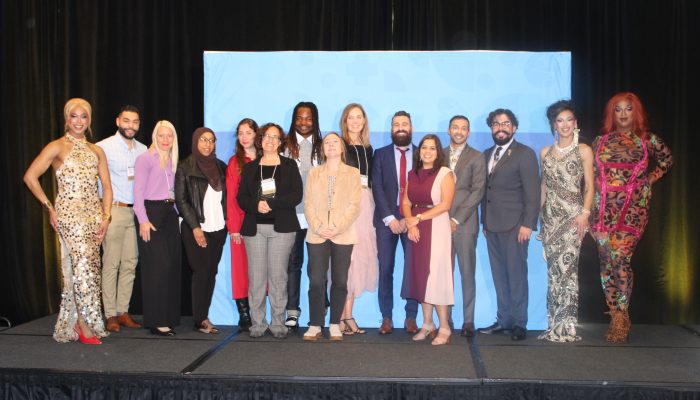We can end the HIV epidemic in Philadelphia right now using the tools we currently have. But we need your help.
The fact that new HIV infections remain stubbornly high in Philadelphia compared to other places speaks to HIV’s enormous footprint on our area. It also indicates the negative effect structural problems, like intergenerational poverty or systemic racism, have on health outcomes regardless of advancements in HIV treatment and prevention. This speaks to the urgent need for us to view public health practices with an equity lens.
This is what our plan, Ending the HIV Epidemic in Philadelphia, does. It is not a special project or one-year grant funded program. It also is not a work plan for the Health Department only. This plan serves as our region’s HIV strategic plan, guiding everything we do to reach a 75 percent reduction in new HIV infections by 2025.
To know what EHE is, what it isn’t, and what it does, please review the six big takeaways below.
Under this plan, HIV will continue to exist but in a much smaller way.
In 2019, 439 Philadelphians newly tested positive for HIV. If this plan succeeds, then in 2025, this number would be reduced to 110 for a total of about 1,371 new HIV diagnoses over five years. Along with new infections being lower, we estimate that, right now, 1,700 Philadelphians living with HIV aren’t aware of their status. If successful, this plan will ensure that over 1,650 of them will know their status by 2025.
It’s not just about diagnosing, though. Right now, only about half of all people living with HIV in our area, a total of 11,125 people, reach viral suppression, commonly called being undetectable. By 2025, should we reach our goals, then this number will increase to 15,260 people.
If we add increasing access to PrEP to this, you start to see a comprehensive strategy. After all, if we increase the number of people who prevent acquiring HIV through PrEP and the number of people who know their status and those who are virally suppressed, then we will clearly reduce new infections.
You might’ve already heard the idea that U=U or undetectable equals untransmittable, that people living with HIV on medication who achieve viral suppression cannot transmit HIV to sex partners. This is backed up by lots of scientific evidence and, when looked at as a prevention strategy, is known as TasP or treatment as prevention.TasP or treatment as prevention.
This plan, then, significantly reduces new infections using PrEP and TasP, meaning fewer people living with HIV in the future.
This also means fewer people at higher risk of heart disease, lung cancer, and other diseases unrelated to HIV that nonetheless are worse in people living with HIV even when they adhere to treatment.
This plan’s story is one of extraordinary community outreach and engagement efforts.
It really is about the journey, not just the destination.
The particular strength of this plan is that it is the culmination of literally thousands of voices over several years. Even when COVID-19 reached Philadelphia, and basically obliterated the planned year of community outreach meetings, the community worked with us, adapted, and overcame.
Some of the community engagement involved:
- Over 8,000 people living with or recently diagnosed with HIV here locally provided insights through interviews across our programming.
- Several formal, commissioned community feedback reports from specific communities providing recommendations.
- Multiple town halls, workshops, and other events solicited feedback.
- Four public comment periods followed different drafts of the plan, each revised as a direct result of this community engagement.
Many people participated virtually through apps and webcams once social distancing became a mainstream concept due to COVID-19. Others participated through phone interviews or email. All of them added their own lived experience, professional insights, and perspectives into the plan.
There are some major changes taking place in strategy.
Bringing new infections down 75 percent over five years requires us to change the way we do things. As a result, some programs will end and others will start.
In particular, community-based HIV testing, a longtime tactic in society’s HIV strategy, has become less effective as the epidemic has changed. For instance, in Philadelphia, about a quarter of all new infections are among youth ages 13 to 24 but community based testing sites generally interact with older populations.
This has an effect on the ability to quickly diagnose new infections; of the 439 new infections in 2019, only 24 came from the 12 organizations focusing on community-based testing. As a result, we are moving away from this tactic and moving toward a more holistic view of HIV treatment and prevention alongside overall health.
Likewise, we must start to view barriers as system failures that can and must be addressed by institutions within the system. For instance, if someone can only make appointments at night because they work, and their provider is only open until 5 p.m., this used to be a barrier the consumer must navigate around and overcome. Today, we would say this is a systemic failure and that the provider should create more opportunities for people to come outside of traditional hours, offer telehealth, or other options.
The plan is for everybody, not just the Health Department, and has four primary pillars while emphasizing workforce development.
While the plan functions as our five-year strategic plan, we need everyone in the local HIV jurisdiction – that is, the entire Philadelphia area and its HIV community but especially the providers we fund – to help us implement it. Otherwise, it cannot work.
The plan has two groups of people in mind, those living with HIV and those at risk of acquiring HIV, served across four primary pillars. These are:
- Diagnosing all Philadelphians with HIV as early as possible.
- Treating people living with HIV quickly and effectively.
- Preventing new transmissions by promoting PrEP and syringe services.
- Responding quickly to HIV outbreaks.
Of course, these pillars require workers at partner organizations.
Understanding how strategic changes will affect workers in the HIV treatment and prevention ecosystem, and that work must be done ensuring organizations reflect the people they serve, we’ve also included workforce development as a special focus of the plan alongside the four pillars. We even held job fairs and created new positions within the Health Department to assist anyone affected by funding changes.
Our plan’s workforce development is about much more than just one job category or program changing; it also requires much more than just additional clinical knowledge. Whether a consumer feels welcome walking in, whether a worker knows about the latest pharmacology, or whether a volunteer knows the importance of respecting someone’s pronouns are all vitally important to this plan.
The plan deploys resources strategically, dynamically changing if and when the epidemic changes as it has.
While it’s true that HIV affects everyone in society, several specific populations will notice the plan’s changes more than others: people living with HIV, people at risk of acquiring HIV, workers at HIV treatment and prevention organizations, public health workers, and other groups.
Systemic based oppressions in society, like racism, make HIV much worse in some communities. For instance, a black man who has sex with other men is more than 14 times likely to acquire HIV than his white counterpart. The plan will affect communities like this more just as HIV does; this is partly why the plan has so much emphasis on community interaction. If the plan isn’t reflective of everyone, especially those most affected by HIV, then it will not succeed.
The plan is a living document, and we will change it in response to the epidemic changing.
While it’s a huge accomplishment that we as a community have this plan after so much planning and engagement, the fact is that we’re taking the same approach to it like when we were drafting it. As new developments occur, or the epidemic changes, we’ll revise it and always remain teachable in order to keep our strategies as effective as possible.




